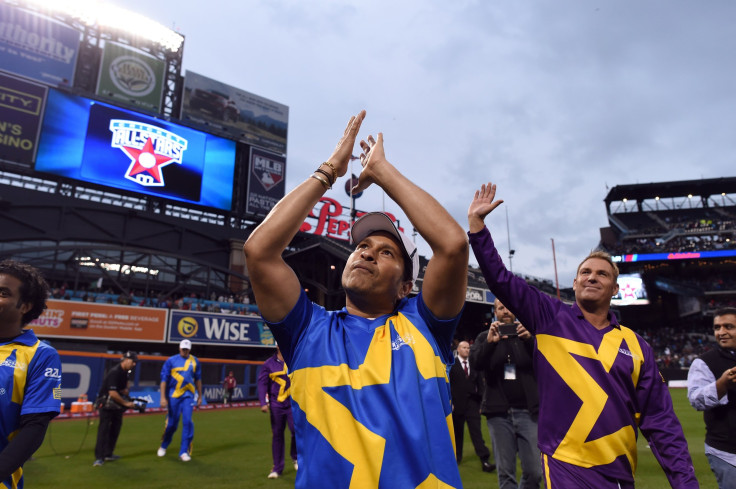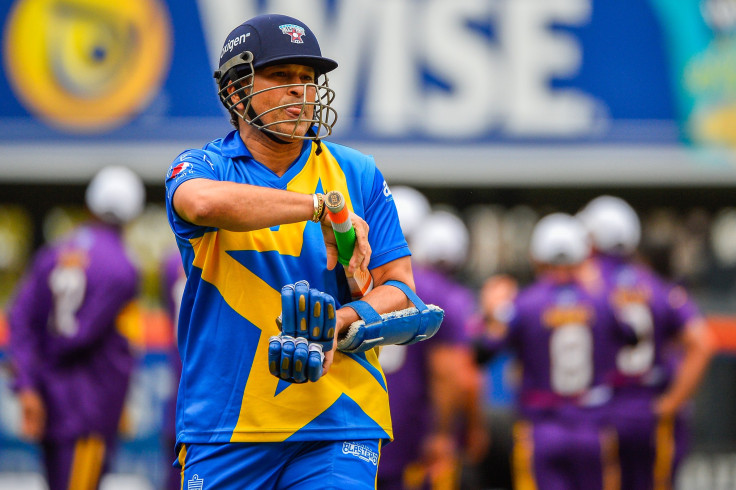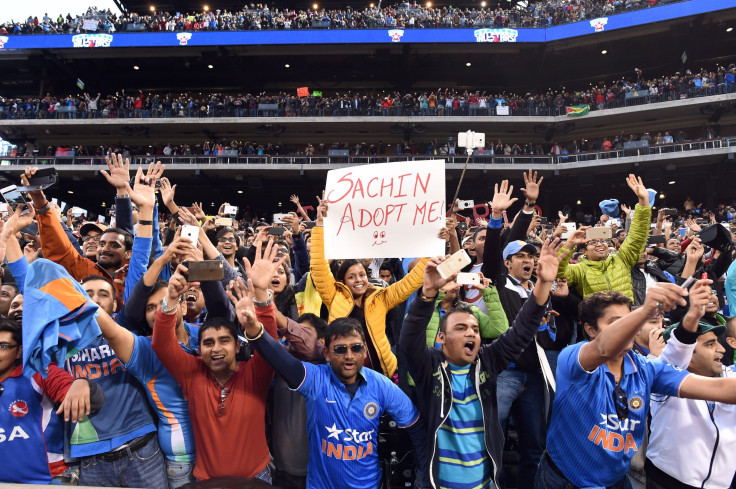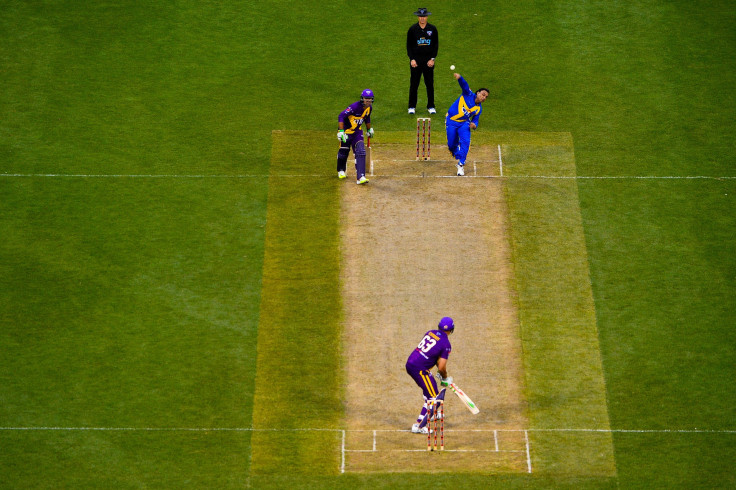Cricket All-Stars Take Over Citi Field, Star Power Of India's Sachin Tendulkar Helps Promote Sport In US

Several stories above the bright lights and bustling activity of New York’s Times Square, a place that begs for your instant attention and offers up immediate gratification perhaps like no other on earth, stood several of the world’s top cricketers from the last 30 years. It was there that they were attempting to promote a sport traditionally played over five days, punctuated by breaks to partake in cucumber sandwiches and tea, where, after all that, a winner is far from guaranteed.
As Sachin Tendulkar, one the greatest cricketers of all time and the most famous Indian alive, explained his mission, it was hard not to think that facing a cricket ball flying toward him at 100 miles per hour had nothing on the challenge he was now embarking on in retirement.
Tendulkar is currently in the United States as part of the Cricket All-Stars series, playing three matches, alongside 29 other famous faces from his sport. In the cricketing world, it is a glittering collection of stars to be sure, but they are now entering an entirely new frontier. Their home for the week will be the Major League Baseball stadiums of the New York Mets, Houston Astros and Los Angeles Dodgers.
“To be here in America, I never thought this day would come,” said Tendulkar, 42, at the New York Marriott Marquis on Thursday. “We’ve come here to win hearts. We want to win the hearts of as many people as possible here and give our best. The reason for picking up a cricket bat again after retirement is to globalize the sport.”

Those are certainly bold words in a country whose history with cricket is long but hardly notable in recent times. As Tendulkar pointed out, cricket in the U.S. dates back to the early 18th century, which is unsurprising given that the sport originated in England and was spread around the world courtesy of the British Empire. As late as the Civil War, cricket was still more widely played than baseball before gradually being usurped by that other game with the wooden bat and ball.
The two sports have continued to veer in drastically different directions since, but cricket is now looking to strike back at America’s Pastime. And it has a new weapon in its armory to set about that arduous task. While the traditional five-day version of cricket (Test cricket) still exists as well as the one-day version, the type played this week in the U.S. is a much quicker, more explosive format which has emerged in the past decade. Twenty20 is played over 20 overs (six pitches) a side, and typically lasts about three hours.
“In the old days cricket was such a long format, and obviously American audiences do not have that length of attention span. Now with this T20 format being brought over here we are very excited to be a part of it,” said Raja Rajamannar, chief global marketing officer for MasterCard,of his company’s sponsorship of the All-Stars event, alongside other blue-chip companies like Citi, Pepsi and Uber.
With a sizable population of ex-pats from the major cricket playing nations, the sport already has a foothold in the U.S. At the first match of the All-Star series Saturday at Citi Field, the passion inspired in a crowd of 36,000, comprised mainly of immigrants from South Asia, the Caribbean, England and Australia, at seeing their heroes was clear. And one player was the star attraction for many in attendance.
“He’s the god of cricket,” New Jersey resident Sid Kummar, decked out in a blue India cricket shirt, said of Tendulkar ahead of the match. “It’s a big moment, cricket is our religion. It’s a once in a lifetime chance. Seeing him in person, I can’t even express in words. He’s like the David Beckham of India, probably even bigger than that.”
Less than a week earlier, Citi Field had played host to the New York Mets and Kansas City Royals in the World Series, yet the devotion on display for the cricket legends was on another level. As one English fan, Jack Goodman, noted, “Tendulkar is probably the most popular sportsman to ever play in this stadium.”
Even so far from home and two years after his retirement, Tendulkar’s appeal was something to behold. He has had crowds of hundreds outside his hotel waiting to catch a glimpse of him, and the Citi Field screams were deafening simply when his face was shown on the big screen. The familiar chant of “Sachin, Sachin,” rang around the stadium as he stood at one end of the pitch waiting to bat, while signs expressing love for the top-scoring batsmen in cricket history littered a crowd that shaded a distinct color of Indian blue. One encapsulated the mood, “God Blessed America,” it read simply.

For fans who now find themselves in the U.S., even watching cricket from their living rooms can be a challenge. Television coverage is close to non-existent, with fans generally having to sign up for online paid-subscription services. Supporters based stateside, then, are accustomed to having to go out of their way to see their native sport, perhaps helping to explain why on Saturday they had come from far and wide.
“We came all the way from Seattle this morning,” Rishabh Animesh, another Indian fan, revealed proudly. “We got in at six in the morning, didn’t sleep. I don’t think we’re going to sleep because the atmosphere is electric.”
But the chance for cricket to catch the casual sports fan has previously been limited. And as fervent as the support was from those in attendance on Saturday, it was notable that there were still ample empty seats in the 45,000 capacity stadium. High ticket prices were cited as an obstacle by some attendees, with ticket costs ranging from $50 up to $175. But it perhaps also reflects the fact that if the sport is to become a true force, then attracting fans outside of the ex-pat community will be key. It was something Australian cricket legend Shane Warne was keen to stress ahead of the matches.
“We also hope that a lot of the Americans will come,” Warne stated. “It’s time to make sure that the people who love cricket bring their American friends to the game and start to educate them about why it’s the second most popular sport in the world behind soccer.”
One of Warne’s former teammates, Glenn McGrath, is married to an American woman and therefore has firsthand experience of just how difficult that education process can be. “We’ve been married coming up to five years. I still don’t think she totally understands it,” he said with a smile. “She keeps ringing when I’m commentating during a Test match. [It's] lunch, day one, she says ‘Who’s winning?’ I said ‘Honey, it’s lunch, day one. No one’s winning at the moment.’”
American accents were in short supply on Saturday, and while some in the crowd had more positive experiences of explaining the game, there were plenty of cautionary tales, too.
“One of my first days in New York I tried to explain it and everyone just stared at me like I was insane,” said Charlie Northcott, who recently arrived from England to study at Columbia University. “You look at the crowd here today, it’s a better reflection of how many people live in America as immigrants, rather than Americans interested in the sport.”
While the best way to start the process would appear to be to make the obvious comparisons with baseball, Bob Dorfman, sports marketing executive with Baker Street Advertising in San Francisco, believes cricket’s similarity could actually be a hindrance.
“It’s not ‘our’ sport. Its rules are difficult to understand quickly and it’s too similar to baseball to carve a solid niche among sports fans.”
Still, those involved have stressed that the trip is far more than just a one-off money-spinning project, and that they are committed to trying to grow the sport among the native population. As well as the three matches, the players are conducting cricketing clinics for children as well as visiting schools. There is a plan to come back next year, they say, with the 30 players signed up initially to play 15 matches around the globe.

Cricket may be widely regarded as the world’s second most popular sport, but currently only 10 countries are considered full members of its governing body, the International Cricket Council (ICC). For the most part, those teams play among themselves. And increasingly, the power has begun to rest with England, Australia, and most of all India.
With a population of over 1.25 billion, 85 percent of whom watch cricket on TV or in the media at least once a week, according to a 2012 survey, it is not hard to see why the Indian market is so crucial to cricket. Indeed, estimates have put India’s contribution to the revenue of world cricket at a massive 80 percent. Some view that dependence as unhealthy.
“We can’t expect that India’s going to continually keep growing the word game like it has, because they are propping up a lot of the other countries around the world,” another of the All-Stars, former Australia captain Ricky Pointing, said.
The ICC has been criticized in the past for not doing enough to globalize the sport. Earlier this year it was confirmed that the World Cup for the one-day version of the game will be reduced to 10 teams, down from 14 in 2015 and 2011 and 16 in 2007, angering members just below the top level, like Ireland.
But the ICC is backing the All-Stars venture, it says, “In line with the strategy to assist in the development of more competitive teams in international cricket. One of the key elements to that is for our top Associate Members to play more cricket against the bottom full members.”
The Associate Members, including the likes of Afghanistan, the United Arab Emirates and Ireland, are those countries where cricket is established but which don’t currently have the infrastructure of the full members.
The United States currently doesn’t feature on either list. Earlier this year, the United States of America Cricket Association was suspended from the ICC after “concerns about the governance, finance, reputation and cricketing activities of USACA.” It was that suspension which meant the ICC took over the right to approve the Cricket All-Stars venture on U.S. shores. Rather than throwing U.S. cricket out into the cold, the ICC claims that they view this as an opportunity to really start building cricket’s popularity.
“We see cricket in the USA, not just from a commercial perspective, although people do talk often about that, but from a cricket perspective, be that grass roots development or national team performance, there is huge potential, but everybody needs to be pushing in the same direction,” Tim Anderson, ICC Head Of Global Development, said.
Getting a U.S. team into one of cricket’s global events would be the next logical step. The U.S. has never competed in a World Cup in any cricket format, with their last global event against the world’s best being the 2004 ICC Champions’ Trophy. Both soccer and more recently rugby in the U.S. have benefited from having a team participating in World Cups. And with rugby now one of the fastest growing sports in the country, Rick Burton, a professor of sports management at Syracuse University and former chief marketing officer for the U.S. Olympic Committee, believes it is a sport cricket would be wise to follow.
“Cricket is a global game, and I think there is enough critical mass in America, if it gets harnessed, that you could see the game have the ability to reach out to that [ex-pat] community,” he explained. “And if they get it going right, they could get new users, new people to play the game. I would look at rugby ... we’ve just come out of the Rugby World Cup, cricket has an equivalent World Cup-type event. I think there’s a lot to be learned about what rugby union is doing well.”
Rugby has also been boosted by its return to the Olympics for 2016. And that is something similarly on the agenda of cricket. There are plenty of obstacles still to resolve, not least from some of the more powerful members of the ICC reluctant to lose out on the revenue from more lucrative events, as well as having to relinquish some autonomy. But a meeting between the ICC and the International Olympic Committee about the plans to have cricket included from 2024 is scheduled for later this month.
Ultimately, though, cricket’s success in America may boil down to whether it can convince the population that it is far from the complex, drawn-out sport it has long been portrayed. For those with such a notion, spin-bowling king Warne has a succinct response.
“We’re trying to hit the stumps and they’re trying to hit it out the park. It’s not that hard.”
© Copyright IBTimes 2024. All rights reserved.










